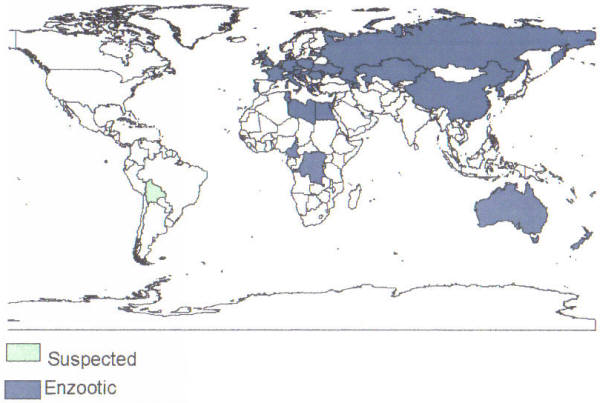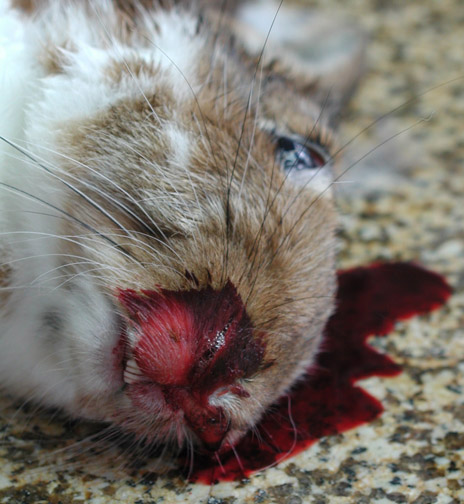Rabbit Hemorrhagic Disease (RHD)
Attention, Rabbit Breeders and Pet Rabbit Owners in and near Nanaimo, Comox, Richmond, Delta, BC
RHD has been diagnosed in the feral rabbit population on the Vancouver Island University campus in February 2018, and has spread to the aforementioned areas.
This outbreak is ongoing!
Please avoid going anywhere near the affected areas, if possible, and take careful quarantine measures as you care for your own domestic rabbits, to prevent spreading the virus to your own rabbits!
(Notice updated June 6, 2018)
Rabbit Hemorrhagic Disease (RHD, RVHD, VHD, or calicivirus) is a catastrophic disease caused by a virus. I pray it never reaches our barn.
What is it?
Also known as Rabbit Viral Hemorrhagic Disease (RVHD), Viral Hemorrhagic Disease (VHD), Rabbit Calicivirus Disease (RCD), Viral Hemorrhagic Fever, or Viral Necrotizing Hepatitis, RHD is a devastating viral disease that will quickly kill 90% or more of your rabbit herd. The virus incubates over 1-3 days, and then you start seeing dead rabbits for no obvious reason in your rabbitry. In rabbit colonies, you may see 90% sick rabbits and when it’s all over, 100% are dead.
The United States is currently free of this virus, however outbreaks have occurred. Aggressive measures have contained and eliminated the threats; this page provides guidelines for breeders and rabbit owners in the western hemisphere.
RHD is endemic in the UK, Europe, Australia, and other countries (outlined below).
See RHVD for guidelines provided to rabbit owners in countries where the virus is endemic.
What are the signs and
symptoms?
The
disease presents itself in three forms, depending on the virulence of the virus
strain and the health and age of the rabbits. The virus is bad news, however
some strains are not as potent as others, depending on the area of the globe in
which you live:
- PERACUTE (very acute
and violent): No signs or symptoms - just a dead rabbit very suddenly. And then
more dead rabbits, because it is exceedingly contagious.
- ACUTE: The rabbit goes off its
feed, is lethargic and has to strain to breathe. Body temperature soars to 105
- 106F, then begins cooling just before the rabbit dies.
- SUBACUTE: Bloody nasal
discharge, tightness and arching in the back and noisy respiration as the
rabbit struggles to breathe. If you see these symptoms, the rabbit may die
within 2-3 hours. In some rabbits under 4 months of age, the rabbit may manage
to recover and then becomes immune.
- But despite being immune, such a rabbit is a likely
to become an asymptomatic carrier of the virus, as the germs
are shed in the urine and excreta for at least a month, and the animal could be
a carrier of the virus for much longer.
What causes Rabbit Hemorrhagic Disease?
The causative agent is a virus known as a calicivirus. The disease was first reported in China in 1984, and has since been reported in most of Europe, parts of Asia, and Mexico (now eradicated). The United States has experienced several isolated outbreaks. See the map, provided by APHIS, which is dated 2000.
In Australia in 1995, after a laboratory 'accident' that released the calicivirus into the environment, 10,000,000 feral rabbits died inside of 8 weeks.
The only good piece of news about the calicivirus is that humans are not susceptible to it.
How does the disease spread?
The virus is sticky. It spreads very easily by direct contact, biting insects, handling infected rabbit meat and by-products, and touching any animate or inanimate object on which the virus sticks, such as food and water crocks and your own clothes and hands, carrying cages, etc. The virus is hardy - it can outlast heat and cold easily, remaining viable in the environment for possibly 2 or more years. It is highly contagious and easily spread.
Photo credit: Center
for Food Security and Public Health, Iowa State Univ.
Follow the link for more necropsy photos.
What will a necropsy show?
Tracheal hemorrhages, pulmonary edema (water-logging of the lung tissues) and congestion, petechiae (tiny hemorrhages) on the myocardium, kidney, and spleen, and extensive hepatic necrosis (liver gangrene).
How can I tell if my rabbits are dying from Rabbit Hemorrhagic Disease?
You can make an initial tentative diagnosis based on the rapidly fatal infection and what your naked eye can see on a necropsy exam. But with such a virulent disease, it is vital to call your vet or the USDA so they can arrange for a VHD-specific PCR (Polymerase Chain Reaction) Test - the proving method used to duplicate and then identify the calicivirus definitively - and either confirm or rule out your initial tentative diagnosis. If positive, the authorities will also want to identify where the calicivirus came from and how it got to your herd.
Is there anything I can do to treat my rabbits?
No, there is no effective treatment.
What should I do if I suspect Rabbit Hemorrhagic
Disease?
If your rabbits start dying for no good reason, you MUST immediately isolate your herd.
- If necropsies support a diagnosis of RHD, kill any remaining animals in your rabbitry. This is the only way to prevent the spread of the infection.
- Immediately report the outbreak to the state veterinarian, and to the USDA. (I would probably also communicate with the vets in my area to give them a heads-up.) Double-bag and freeze some carcasses for disease confirmation.
- Careful sanitation and disinfection are imperative to halting or limiting the spread of Rabbit Hemorrhagic Disease, as is the maintenance of a closed herd.
- Disinfect everything that has come into contact with your rabbits.
- In some areas of the world where the disease is
endemic in native rabbit populations, killed virus vaccines can provide some
modicum of protection.
It is believed that the cottontails native to the New
World are NOT susceptible to RHD, however domestic rabbits are of the same
genus and species as rabbits native to Europe, which are susceptible, and which
carry the infection.
The Rabbit Industry Council has prepared an excellent handout on RHD in PDF form. Get the Rabbit Hemorrhagic Disease Info Flyer here.
Rabbit Production, 1996 Edition
How to Respond in the Case of a Rabbit Hemorrhagic Disease Outbreak In or Near Your Locality
An isolated outbreak of Rabbit Hemorrhagic Disease occurred in Pine County, Minnesota, in April, 2010. This was the last known outbreak in the United States. It was fully contained.
If you are an owner of one or more rabbits and/or you go to rabbit shows, hear is what to do in the case of another outbreak in the USA, and especially one close to where you live.
This Rabbit Hemorrhagic Disease announcement comes directly from the
RABBIT INDUSTRY COUNCIL, quoted with permission:
Rabbit Viral Hemorrhagic Disease (RVHD)
In the case of nearby RVHD, should you panic? No.
While frightening in its tenacity and ease of transmission, this disease can be managed and limited in spread by common precautions. It should never be treated lightly or disregarded.
We STRONGLY encourage those in [an area of active outbreak and surrounding areas] to think carefully about any unexplained deaths in their herds and to take the appropriate steps for accurate diagnosis should symptoms and signs indicate any possibility of RVHD. If you have any doubts, contact your State Veterinarian for assistance--or contact the Rabbit Industry Council at 530-534-7390 or RIC@cncnet.com.
We also STRONGLY encourage all shows and exhibitors to use an appropriate disinfectant [see RHD Info Flyer link above] on all coops, carpets, and equipment. If you are uncertain of your herd health status, please stay home until you get it straightened out.
References:
- https://www.aphis.usda.gov/animal_health/emergency_management/downloads/sop/sop_rhd_e-e.pdf
- https://www.aphis.usda.gov/animal_health/downloads/Rabbit-Hemorrhagic-Disease_062018.pdf
- https://www.aphis.usda.gov/animal_health/emergency_management/downloads/disinfection-options-for-rabbit-hemorrhagic-disease.pdf
- http://dora.missouri.edu/rabbits/viral-hemorrhagic-disease-virus-rhdv/
Double-Value Guarantee
Our policy is to always OVER-deliver
on value,
which is why your purchase is fully covered by our
Double-Value
Guarantee.
Go ahead - take any of our e-books for a test drive. Peruse our detailed informational and educational e-books. Examine our plans for building rabbit cages, runs, or metal or PVC hutch frames. Check out the Rabbit Husbandry info e-books.
If you aren't completely satisfied that your e-book purchase is worth at least double, triple or even quadruple the price you paid, just drop us a note within 45 days, and we'll refund you the entire cost. That's our Double-Value Guarantee.
Note: When you purchase your
e-books, they will be in PDF format, so you can download them to any device that
supports PDF format. We advise making a back-up copy to a drive or cloud
account. If the books are lost, you can also purchase another copy from Raising-Rabbits.












New! Comments
Have your say about what you just read! Leave me a comment in the box below.